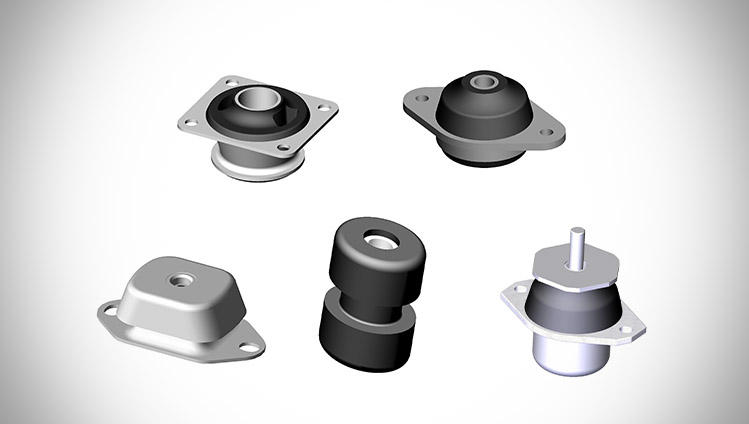The Impact of Worn-Out Engine Mounts on Fuel Efficiency
Fuel efficiency is a critical aspect of vehicle performance that directly affects operational costs and environmental impact. While many drivers focus on tire pressure, air filters, or engine tuning to optimize fuel economy, one often overlooked component can also play a significant role—engine mounts.
Engine mounts are designed to secure the engine in place, reduce vibration, and maintain alignment between engine and transmission systems. When these mounts become worn out or damaged, they can create a chain reaction of issues that negatively affect fuel consumption and overall vehicle performance.
In particular, when engine mounts fail to perform their role, the engine may shift or vibrate excessively, resulting in misalignment, increased engine load, and reduced efficiency. Understanding how this happens can help you identify issues early and take corrective action before your fuel economy takes a hit.
What Do Engine Mounts Do?
Before diving into how worn-out mounts impact fuel consumption, it’s important to understand their primary functions:
- Stabilization: They keep the engine securely fastened to the vehicle’s chassis.
- Vibration dampening: Engine mounts absorb engine vibrations to ensure a smoother ride.
- Alignment maintenance: They help keep the engine and transmission properly aligned for smooth power transfer.
When mounts are in good condition, these functions contribute to efficient operation and minimal power loss. However, once engine mounts degrade, they can no longer absorb shock or maintain engine stability effectively.
How Worn-Out Engine Mounts Affect Fuel Efficiency
There are several ways worn-out engine mounts can reduce fuel efficiency, both directly and indirectly:
1. Increased Engine Movement
When an engine is not firmly held in place, it tends to shift during acceleration, deceleration, or while climbing hills. This constant movement requires the engine to work harder to deliver the same performance, which in turn uses more fuel. It also causes drivetrain misalignment, making energy transfer less efficient.
2. Loss of Power Transmission Efficiency
Engine mounts help maintain a precise connection between the engine and transmission. When they wear out, this connection weakens. Power generated by the engine is not transferred as smoothly to the wheels, resulting in energy losses and the need for more fuel to maintain speed and performance.
3. Misalignment and Friction
A misaligned engine can affect the alignment of belts, pulleys, and other connected components. This leads to increased friction and wear, which forces the engine to expend more energy and fuel to overcome resistance.
4. Unstable Idling and Fuel Management
A vibrating engine can affect fuel injection sensors and engine control systems. If the sensors receive inconsistent signals due to engine instability, the fuel management system may inject either too much or too little fuel, both of which result in inefficient combustion.
5. Driver Compensation
When drivers notice excessive vibrations, noises, or sluggish acceleration, they may unknowingly press harder on the accelerator. This behavior increases fuel usage, especially in stop-and-go traffic or when climbing inclines.
Other Consequences Beyond Fuel Efficiency
While fuel economy is a major concern, ignoring worn engine mounts can lead to broader problems, such as:
- Damage to the exhaust system
- Premature wear on hoses, belts, and wiring
- Transmission issues due to misalignment
- Increased cabin noise and reduced driving comfort
These issues not only increase maintenance costs but can also lead to reduced resale value and more frequent repairs.
Warning Signs of Failing Engine Mounts
To catch problems early and preserve fuel efficiency, be alert to these signs:
- Excessive vibration in the cabin
- Clunking or banging sounds when shifting gears
- Engine visibly shifting or rocking under the hood
- Decrease in fuel economy with no other apparent cause
If you notice any of these symptoms, it’s advisable to inspect the mounts or consult a technician. Replacing failing engine mounts can restore proper alignment and help improve fuel efficiency.
Preventive Measures to Maintain Fuel Economy
You can take several steps to ensure your engine mounts remain in good condition and continue supporting optimal fuel use:
- Regular inspections: During routine maintenance, check engine mounts for signs of wear, such as cracks, fluid leaks (in hydraulic mounts), or separation.
- Avoid aggressive driving: Sudden acceleration or hard braking can place extra stress on mounts, accelerating wear.
- Address engine or transmission issues promptly: Excessive vibrations or knocking should never be ignored, as they often indicate underlying problems.
- Use quality replacement parts: If a mount needs replacement, ensure you’re using the right type and size for your vehicle to maintain performance standards.
Final Thoughts
While they may seem like simple components, engine mounts play a vital role in maintaining fuel efficiency by keeping your engine properly positioned and operating smoothly. When mounts wear out, the increased vibration, movement, and misalignment they cause can significantly reduce your vehicle’s fuel economy.
Staying proactive through regular inspections and timely replacements can make a measurable difference in both fuel costs and overall engine performance. If you’re looking to maintain fuel efficiency and protect your engine, don’t overlook the importance of maintaining your engine mounts.






